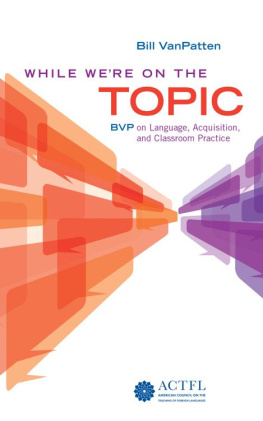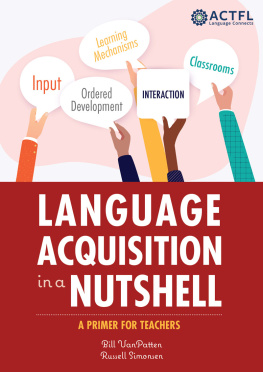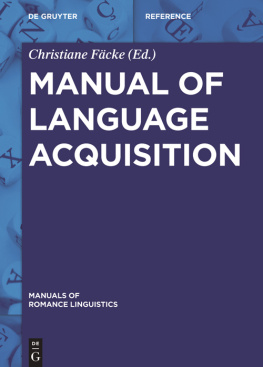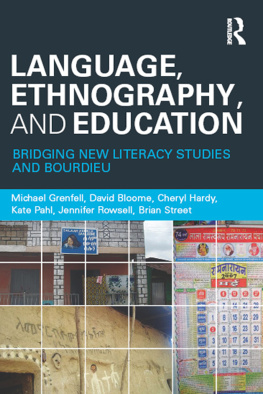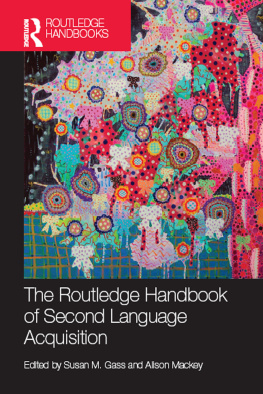Bill VanPatten - While Were On the Topic: BVP on Language, Acquisition, and Classroom Practice
Here you can read online Bill VanPatten - While Were On the Topic: BVP on Language, Acquisition, and Classroom Practice full text of the book (entire story) in english for free. Download pdf and epub, get meaning, cover and reviews about this ebook. year: 2020, publisher: ACTFL, genre: Children. Description of the work, (preface) as well as reviews are available. Best literature library LitArk.com created for fans of good reading and offers a wide selection of genres:
Romance novel
Science fiction
Adventure
Detective
Science
History
Home and family
Prose
Art
Politics
Computer
Non-fiction
Religion
Business
Children
Humor
Choose a favorite category and find really read worthwhile books. Enjoy immersion in the world of imagination, feel the emotions of the characters or learn something new for yourself, make an fascinating discovery.
- Book:While Were On the Topic: BVP on Language, Acquisition, and Classroom Practice
- Author:
- Publisher:ACTFL
- Genre:
- Year:2020
- Rating:4 / 5
- Favourites:Add to favourites
- Your mark:
- 80
- 1
- 2
- 3
- 4
- 5
While Were On the Topic: BVP on Language, Acquisition, and Classroom Practice: summary, description and annotation
We offer to read an annotation, description, summary or preface (depends on what the author of the book "While Were On the Topic: BVP on Language, Acquisition, and Classroom Practice" wrote himself). If you haven't found the necessary information about the book — write in the comments, we will try to find it.
Bill VanPatten: author's other books
Who wrote While Were On the Topic: BVP on Language, Acquisition, and Classroom Practice? Find out the surname, the name of the author of the book and a list of all author's works by series.
While Were On the Topic: BVP on Language, Acquisition, and Classroom Practice — read online for free the complete book (whole text) full work
Below is the text of the book, divided by pages. System saving the place of the last page read, allows you to conveniently read the book "While Were On the Topic: BVP on Language, Acquisition, and Classroom Practice" online for free, without having to search again every time where you left off. Put a bookmark, and you can go to the page where you finished reading at any time.
Font size:
Interval:
Bookmark:
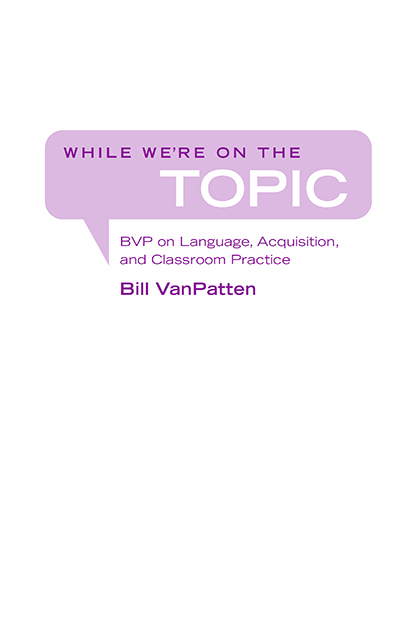
Graphic Design by Dever Designs
ISBN: 978-1-942544-58-6
2017 by The American Council on the Teaching of Foreign Languages
1001 North Fairfax Street, Suite 200
Alexandria, VA 22314
All rights reserved. No part of this book may be reproduced, in any form or by any means, without expressed written consent of the publisher.
Books like these dont come out of thin air. What I mean is: while some of the ideas in this book are mine, much, if not most, of what appears on these pages is owed to those who have done the research and contributed significantly to the fields that shape language acquisition and language teaching, particularly: Noam Chomsky, Steven Pinker, Sandra Savignon, Larry Selinker, S. Pit Corder, Stephen Krashen, Tracy Terrell, Lydia White, Patsy Lightbown, James F. Lee, Michael Sharwood Smith, and Susan Gass. There are others, to be sure, but I would be especially remiss if I did not mention these great people here. Of course, what I have written does not necessarily reflect their thoughts about language teaching or the implications for language instruction from fields such as linguistics, language acquisition, and communication.
I would also like to thank a number of people who read parts of this manuscript during its development and either made comments or offered words of encouragement. In no special order, because they are all great people, my thanks go to: Michael Coxon, Carol Gaab, Eric Herman, Stephen Krashen, Paul Mandell, Barbara Sawhill, Megan Smith, Ali Moeller Of course, I owe much to everyone at the American Council on the Teaching of Foreign Languages (ACTFL) who made this book happen, including Marty Abbott, Howie Berman, Pete Swanson, and especially Meg Malone and Lisa Campo. And thanks to Todd Larson for his editing job.
Finally, my thanks to all of my studentsundergrads and graduates who have pushed me to hone ideas and present them in a distilled yet fun way over the years. This is a great profession!
This is not your typical text on language teachingand youll see why as you begin to engage the topics. This book aims to bring certain basic ideas back into focus for both novice instructors and veterans.
I want to start by talking about the nature of contemporary language teaching. Just what is it? The answer depends on who you talk to. Here I want to suggest something to you, the reader: Contemporary language teaching is communicative language teaching, and communicative language teaching is contemporary language teaching.
Yet communicative language teaching has a bad rap in the profession. Why? Largely because many people never quite understood its underlying tenets. Perhaps they were never made clear. For whatever reason, communicative language teaching became a buzzword everyone thought they understood but maybe really didnt. The outcome: communicative language teaching became whatever people wanted it to be.
But easily articulated principles do underlie communicative/contemporary language teaching. Andtraditional approaches asideI would argue that proficiency-based language teaching, TPRS, The Natural Approach, immersion and content language teaching, among others, are all examples of communicative language teaching. Why? Because they are all driven by the same underlying principlesat least, presumably so.
So, to repeat, I start with the premise that contemporary language teaching (CLT) is communicative language teaching (CLT) in one form or another. That is, CLT = CLT. Furthermore, there is no singular way to do CLT. Hearing people say the communicative method or the communicative approach (as opposed to a communicative method/approach) is like hearing The Star Spangled Banner sung off-key: it doesnt sound pretty on the earsat least not on mine. I react negatively, because saying the communicative method demonstrates how people simply misunderstand the most important and insightful revolution in language teaching. Hopefully this book will help to clarify why.
My intent, then, is to cover the basics and review the underlying principles for CLT so that, no matter what approach an instructor adoptsor even if an instructor fashions a unique curriculum, a personal methodthat approach is not put together based on myth or popular perception. Instead, I hope teachers will make curricular decisions based on ideas informed by theory and research. But that doesnt mean you have a dense, theory-laden, research-heavy tome in your handsjust look at how brief this book is. My goal is to make an informed approach to CLT fun to read.
Now its time for the sneak peek: What are the principles underlying CLT? It is arguable (somewhat) what the list should be, but we have to start somewhere. And so, for better or for worse, I will present the basics in a series of six major principles for CLT:
If you teach communicatively, youd better have a working definition of communication . My argument for this is that you cannot evaluate what is communicative and what is appropriate for the classroom unless you have such a definition.
Language is too abstract and complex to teach and learn explicitly. That is, language must be handled in the classroom differently from other subject matter (e.g., history, science, sociology) if the goal is communicative ability. This has profound consequences for how we organize language-teaching materials and approach the classroom.
Acquisition is severely constrained by internal (and external) factors. Many teachers labor under the old present + practice + test model. But the research is clear on how acquisition happens. So, understanding something about acquisition pushes the teacher to question the prevailing model of language instruction.
Instructors and materials should provide student learners with level-appropriate input and interaction. This principle falls out of the previous one. Since the role of input often gets lip service in language teaching, I hope to give the reader some ideas about moving input from technique to the center of the curriculum.
Tasks (and not Exercises or Activities) should form the backbone of the curriculum. Again, language teaching is dominated by the present + practice + test model. One reason is that teachers do not understand what their options are, what is truly communicative in terms of activities in class, and how to alternatively assess. So, this principle is crucial for teachers to move toward contemporary language instruction.
A focus on form should be input-oriented and meaning-based. Teachers are overly preoccupied with teaching and testing grammar. So are textbooks. Students are thus overly preoccupied with the learning of grammar. This principle demonstrates what should be the proper approach to drawing learners attention to grammatical features in the contemporary classroom.
Again, to be sure, these are principles I have selected for this book. Why these and not others? My reasoning is twofold:
My experience over the years suggests that without these six principles, no real change can happen. These are the basics of the basics.
I believe a book on language teaching should be short and to the point. Sometimes less is more. Imagine the instructor-in-training getting out of a course on language teaching with six basic ideas under her belt that she is ready to use to develop and evaluate language teachingsix ideas she knows well and will carry with her. These basics will let her better understand standards, guidelines, and anything else thrown at her. Again, sometimes less is more.
The audience for this book is wide-ranging, but importantly, you dont have to be a scholar in language teaching or language acquisition to read it. As I started writing, I had in mind two groups of people as readers. The first group was teachers-in-training. My idea was that this book could be used in a class as either a main text or as a supplement. I have used the manuscript as the principal text in my own Foundations of Contemporary Language Teaching (CLT) course. For this reason, included along the way are lists of foundational readings, discussion questions and food for thought, as well as I statements at the end of each chapter so readers can reflect on what they now know and can talk about.
Font size:
Interval:
Bookmark:
Similar books «While Were On the Topic: BVP on Language, Acquisition, and Classroom Practice»
Look at similar books to While Were On the Topic: BVP on Language, Acquisition, and Classroom Practice. We have selected literature similar in name and meaning in the hope of providing readers with more options to find new, interesting, not yet read works.
Discussion, reviews of the book While Were On the Topic: BVP on Language, Acquisition, and Classroom Practice and just readers' own opinions. Leave your comments, write what you think about the work, its meaning or the main characters. Specify what exactly you liked and what you didn't like, and why you think so.

